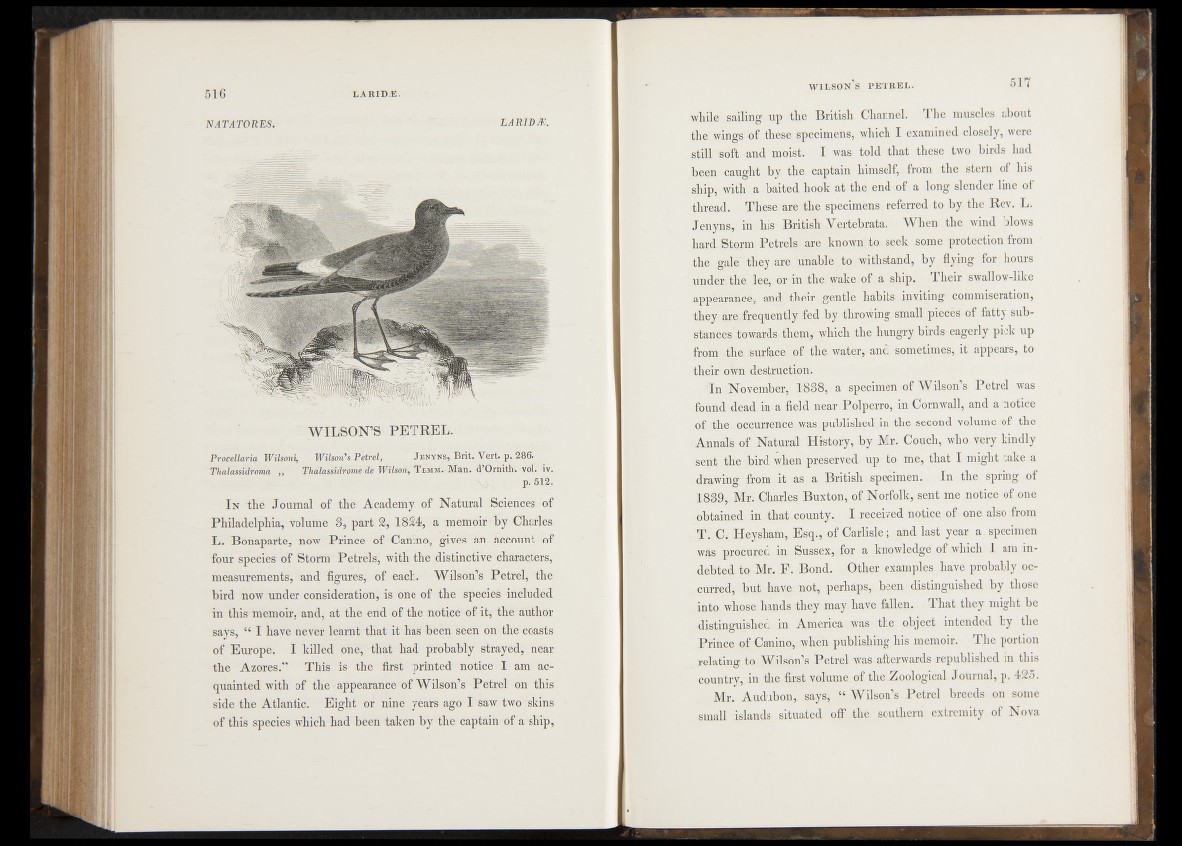
NATATORES. LARIDM.
' WILSON’S PE T R E L .
Procellaria Wilsoni, ' Wilson’ss-Petrel, J enyns, Brit. Vertjp.
Thalassidroma „ ThatasMrorne de d’Ornith* 'vol. iv.
p. 512.
In the Journal of the Academy of Natural Sciences of
Philadelphia, volume 3, part 2,'1824, a memoir by Charles
L. Bonaparte, now Prince of Canmo, gives an account of
four species of Storm Petrels, with the distinctive characters,
measurements, and figures, of each. Wilson’s Petrel, the
bird now under consideration, is one of the species included
in this memoir, and, at the end of the notice of it, the author
says, “ I have never learnt that it hafe -been seen on the coasts
of Europe. I killed one,vthat*had probably slrayeNtf near
the Azores.” This is* the firstr -printed notice I am acquainted
with of the appearance of Wilson’s Petrel ok this
side the Atlantic. Eight or nine years ago I saw two skins
of this species which had been taken by the captain of a ship,
Wil s o n ’s p e t r e l . 517
while sailing up the British Channel. The muscles about
the wings of these specimens, which I examined closely, were
still soft and moist. I was told that these two birds had
been' caught the captain himself, from the stern of his
s|iip, with a baited hook at the end of a long slender line of
thread. These are the specimens referred to by the Rev. L.
Jenyns, in his British Vertebrata. When . the wind blows
hard. Storm Petrels are known to-~seek some protection from ;
the gale they are unable, to withstand, by flying for hours
^nder the lee, or in the wake of a, ship.,'v Their swallow-like
appearance^ ,and their gentle -habits • inviting commiseration,
thepfape^frequently fed b^jhto^rng small pieces of fatty substances
"towards them-,' which the hungry birds' eagerly pick up
from-dhe surface of the water, and sometimes, it appears, to
thefr own destruction.
i n November, 1838;: a specimen of Wilson’s Petrel was
-found dead in a field near Polperrp, in Cornwall, and a notice
of the. occurrence!was puMi^hedjan the second volumilpf the
Annals Natural History, by Mr. Couch, who very kindly
sent the bird when preserved, up to me, that I might take a
drawing from it as. a British specimen. In the spring of
1839., Mr. Charley Buxton, pf Norfolk, sent me notice of one
obtaimedt.in that c<^uuty..j > % ^ y e d notice of. one also from
T. C. Heysbam, Esq., of Carlisle; and last year a specimen
was procured in .Sussex,sfor a knowledge of which I am indebted
to Mr. F . Bond. Other examples have probably occurred,
but have not, perhaps, been distinguished by those
into whpse hands they may have fallen. That they might be
distinguished*^ America wasrth# object intended by the
Prince,iof?^apino,iWheh-; publishing his memoir. The portion
^ relating to Wilson’s Petrel was afterwards republished in this
country, in therfirst volume of the Zoological Journal, p. 425.
Mr. Audubon, says, “ Wilson’s Petrel breeds "on some
small islands situated off1 the southern extremity of Nova